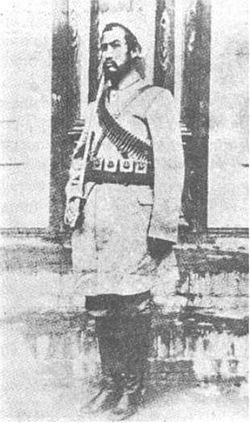Abdullah Bughra
Abdullah Bughra | |
|---|---|
 Abdullah Bughra | |
| Emir of the First East Turkestan Republic | |
| In office 1933 – April 1934 | |
| Personal details | |
| Born | Khotan |
| Died | April 1934 Yarkand |
| Nationality | Chinese |
| Political party | |
| Relations | Muhammad Amin Bughra, Nur Ahmad Jan Bughra |
Abdullah Bughra (Uyghur: (Kona Yëziq) ئابدۇللا بۇغرا, عبد الله بغرا; Chinese: 阿不都拉·布格拉; pinyin: Ābùdūlā·Bùgélā; died 1934)[2] was a Uighur Emir of the First East Turkestan Republic. He was the younger brother of Muhammad Amin Bughra and older brother of Emir Nur Ahmad Jan Bughra. He commanded Uighur and Kirghiz forces during the Battle of Kashgar (1934) against the Chinese Muslim 36th Division (National Revolutionary Army). The Chinese Muslims were loyal to the Chinese government and wanted to crush the Turkic Muslim Uighurs and Kirghiz in revenge for the Kizil massacre. He also had Afghan bodyguards protecting him. He was killed in 1934 at Yarkand by Chinese Muslim troops under general Ma Zhancang. All of Abdullah's fighters were killed, but his body was never found, which later gave rise to speculations about his fate.[3]
Several sources state that Abdullah's head was cut off after he was killed and sent to Id Kah Mosque to be put on display.[4][5]
References[edit]
- ^ Andrew D. W. Forbes (1986). Warlords and Muslims in Chinese Central Asia: a political history of Republican Sinkiang 1911-1949. Cambridge, England: CUP Archive. p. 64. ISBN 0-521-25514-7. Retrieved 2010-06-28.
- ^ Ondřej Klimeš (8 January 2015). Struggle by the Pen: The Uyghur Discourse of Nation and National Interest, c.1900-1949. BRILL. pp. 122–. ISBN 978-90-04-28809-6.
- ^ Andrew D. W. Forbes (1986). Warlords and Muslims in Chinese Central Asia: a political history of Republican Sinkiang 1911-1949. Cambridge, England: CUP Archive. p. 84. ISBN 0-521-25514-7. Retrieved 2010-06-28.
- ^ Christian Tyler (2004). Wild West China: the taming of Xinjiang. New Brunswick, New Jersey: Rutgers University Press. p. 116. ISBN 0-8135-3533-6. Retrieved 2010-06-28.
- ^ Andrew D. W. Forbes (1986). Warlords and Muslims in Chinese Central Asia: a political history of Republican Sinkiang 1911-1949. Cambridge, England: CUP Archive. p. 123. ISBN 0-521-25514-7. Retrieved 2010-06-28.
External links[edit]
- 1934 deaths
- Uyghurs
- East Turkestan independence activists
- People executed for treason against China
- People executed by the Republic of China by decapitation
- Young Kashgar Party politicians
- Republic of China politicians from Xinjiang
- People from Hotan
- 20th-century executions by China
- Executed people from Xinjiang
- Muslims from the Chinese Empire
